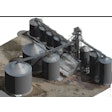
To listen to Newsline please visit newsline.fb.org
| Clements: |
Farmers are poised to enjoy a bountiful harvest this year, but it won’t come without concern. Feed and Grain Magazine Editor Elise Schafer says grain will have competition on the railway this year where problems persist in areas like the Upper Midwest. Some farmers are still trying to move last year’s crop. |
| Schafer: | That’s because grain is competing for rail cars, locomotives and track space with the oil industry and so far it seems like the railroads are favoring the oil customers. The grain industry is putting a lot of pressure on the railroads to clear the backlog of railcars from the winter. The railroads are saying that they’re going to make significant investments to avoid this kind of problem going long-term, so we’ll see how that pans out. |
| Clements: |
Near the Upper Mississippi River a late and wet harvest is causing quality concerns. Schafer says grain handlers will be testing loads for quality and may have to eventually turn away loads. However, she says grain handlers are preparing for the large harvest. |
| Schafer: | Grain handlers are well-prepared to take on the extra volume. All summer they’ve been watching the crop reports and elevators and co-ops are investing in permanent storage and temporary storage solutions. A lot of them have set up circle or oval ground piles and those can store up to a million and a half bushels. It does depend on the region and the situation but most places in the Midwest are pretty low on inventory right now. So at least at the beginning of harvest, they should be accepting grain. |
| Clements: |
Schafer says farmers should be talking with their local co-ops and elevators about grain storage, planning ahead to avoid problems. She adds one solution to on-farm storage is plastic grain bags. |
| Schafer: |
It is fairly expensive and labor-intensive, but I’ve heard high-quality grain coming out of grain bags even a year after they’ve been loaded. The key is to load them dry. You want to decrease the possibility of mold or mycotoxins once it’s loaded so you need to monitor them constantly. Be sure to get a good sample for testing once you’ve unloaded it to help determine the quality and then you can decide how you want to market it. |
| Clements: |
Micheal Clements, Washington. |











